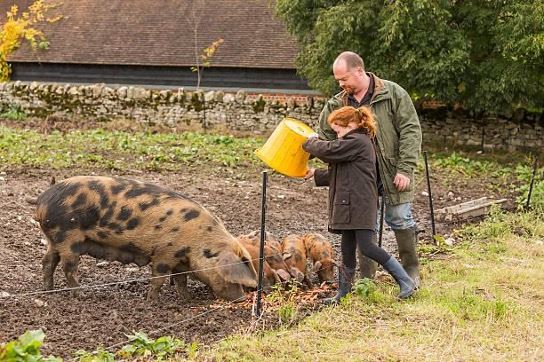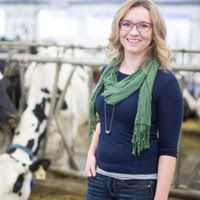
Source: Getty Images
Whether it be from supermarkets, restaurants or our own kitchens, people throw away a lot of food. Or rather, they feed it to animals.
In many countries Canada, close to 40 per cent of total food loss comes from these later stages of the supply chain1. While cycling food waste towards animal feed may seem like a noble approach to handling this challenge, the question remains: is food waste safe for animals?
Food waste materials are defined differently, depending on where they come from within the supply chain2. The term “food loss” refers to waste generated during food processing and manufacturing (many of these items are safely diverted to animal feed in the form of by-products). The term “food waste” refers to items discarded at retail or consumer levels. These carry a higher risk for harbouring contaminants and disease.
Feeding uncooked food waste to animals not only puts their health at risk, but also the entire food chain – especially if that food waste is contaminated with meat products. In 2009, 25 to 35 per cent of the global pork supply was wiped-out from African swine fever – a highly transmissible viral disease that has been linked with feeding food waste to pigs 3. In 2001, more than six million lambs, pigs and cattle died during the European foot-and-mouth disease epidemic which was linked to the feeding of uncooked food waste to animals.4. Other diseases like vesicular exanthema (a swine disease similar to foot-and-mouth), trichinosis (caused by parasitic roundworms in pigs), and bovine spongiform encephalopathy (BSE, a.k.a. “mad cow” disease) have also had devastating effects on livestock industries. All been linked to improper feeding of food waste products
Raw food waste can also harbour infectious organisms worrisome to public health, even if the food waste is plant-based. The risk of plant-based food waste being contaminated with Salmonella, for example, may depend on the type of plants it came from. A study published in Frontiers of Microbiology found that certain vegetable plants tend to be colonized by Salmonella more than others5. So, even if raw food waste is free of meat contaminants that doesn’t necessarily mean it’s safe for our animals.
Heavy metals and toxins are another risk factor to be considered before feeding food waste to livestock. A survey of European household and restaurant waste found that the levels of lead, cadmium and dioxins exceeded allowable limits for livestock feed6. These compounds accumulate in the food chain and can negatively impact human and animal health.
From animal feed, to animal welfare, to public health, all stages of the food supply chain are connected. That’s why many countries have implemented strict regulations around the use of food waste as animal feed. And while the practice of feeding food waste to our animals has decreased, it has not been eliminated. A survey from the United Kingdom estimated that 24 per cent of small producers continue to feed uncooked household food waste to their livestock3.
In Canada, feeding raw household or donated food waste to a producer’s own animals is allowed. It is the exception to the rules, as long as it isn’t contaminated with meat and the resulting animal products to anyone else7. These exceptions are confusing and send conflicting messages about the safety of the practice and raise concerns throughout the food industry.
This article first appeared in The Western Producer
References:
- Gustavsson, J., Cederberg, C., Sonesson, U., van Otterdijk, R., & Meybeck, A. (2011). Global Food Losses and Food Waste: Extent. Causes and Prevention, 29.
- FAO, I. (2016). WFP. The State of Food Insecurity in the World: Meeting the 2015 international hunger targets: taking stock of uneven progress. 2015.
- Gu, H.; Daly, T. (2019). China has Shown ‘Shortcomings’ in Bid to Contain African Swine Fever. Retrieved from https://uk.reuters.com/article/us-china-swinefever-policy/china-has-shown-shortcomingsin-bid-to-contain-african-swine-fever-cabinet-idUKKCN1TY15E
- UK House of Commons Report. (2002). The 2001 Outbreak of Foot and Mouth Disease; UK House of Commons Report. Retrieved from https://www.nao.org.uk/wp-content/uploads/2002/06/0102939.pdf
- Jechalke, S., Schierstaedt, J., Becker, M., Flemer, B., Grosch, R., Smalla, K., & Schikora, A. (2019). Salmonella establishment in agricultural soil and colonization of crop plants depend on soil type and plant species. Frontiers in microbiology, 10, 967.
- García, A.J., Esteban, M.B., Márquez, M.C., Ramos, P. (2005). Biodegradable municipal solid waste: characterization and potential use as animal feedstuffs. Waste Manag. 25, 780–787.
- CFIA. (2019). Recycled Food Products. In Regulatory Guidance: Feed Registration Procedures and Labelling Standards. Retrieved from https://www.inspection.gc.ca/animal-health/livestock-feeds/regulatory-guidance/rg-1/chapter-3/eng/1329319549692/1329439126197?chap=19
- Gillespie A, Grove-White D, Williams H (2015). Should cattle veterinarians be concerned about disease risk from smallholder and pet pigs? In: Presented at the Middle European Buiatric Congress10th ECBHM Symposium, Maribor, Slovenia.
By: Janna Moats

Janna Moats is a Professional Agrologist and science writer based in Saskatoon. She obtained her Master of Science degree in Animal Science from the University of Saskatchewan and has worked across various sectors of the agriculture and agri-food industry. Connect with her on LinkedIn: www.linkedin.com/in/jannamoats
